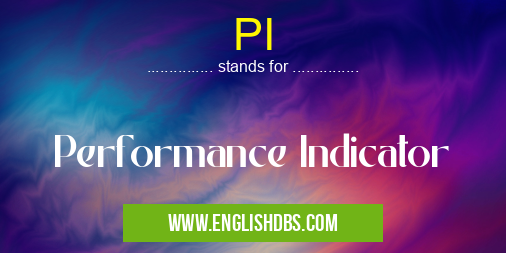What does PI mean in STOCK EXCHANGE
Performance Indicators, commonly abbreviated as PIs, are intended to measure the performance of an organization, teams or individuals. Generally used in business settings, PIs provide businesses with a comprehensive way to quantify their success within certain areas and enable companies to benchmark and adjust their performance with more accuracy. This is particularly important in a competitive global marketplace where every little advantage counts.

PI meaning in Stock Exchange in Business
PI mostly used in an acronym Stock Exchange in Category Business that means Performance Indicator
Shorthand: PI,
Full Form: Performance Indicator
For more information of "Performance Indicator", see the section below.
Definition
A Performance Indicator (PI) is a measurable value that reflects how effectively an organization or individual is achieving key objectives and goals. They provide insight into the degree of success by quantifying the current level of performance for any given activity. Performance Indicators can be derived from static sources such as financial summaries, or obtained from dynamic sources such as customer feedback surveys.
Uses
Performance indicators are used in many different contexts across various industries. For example, businesses may use them to track sales productivity, customer satisfaction ratings, return on investment (ROI) levels and market share growth rate. Non-profit organizations may track volunteer engagement levels and donations received over time. Governments may use performance indicators to monitor employment rates and economic growth levels.
Advantages
By using Performance Indicators to measure progress towards targets, businesses can ensure that they’re prioritizing goals correctly and making necessary changes when needed. This helps maximize efficiency within the company while ensuring top quality results are produced over time. Regularly tracking progress also assists with accountability by highlighting any areas where additional effort or resources may be needed in order to meet objectives or reach milestones on time.
Challenges
Creating effective performance indicators requires careful thought and consideration as it is easy to get bogged down in too much data or focus on details that are irrelevant when looking at the bigger picture. Additionally, it can be difficult to track user-defined indicators accurately if not enough relevant information has been collected about them beforehand or if there is no standardized system for tracking it accurately over time.
Essential Questions and Answers on Performance Indicator in "BUSINESS»STOCKEXCHANGE"
What is a Performance Indicator?
A Performance Indicator (PI) is used as a metric to gauges the performance of an individual, team, department or organization. The objective of PI’s is to help organizations identify areas for improvement and to promote success.
How are Performance Indicators calculated?
Performance Indicators are typically calculated based on different variables such as financial metrics, customer service ratings and employee engagement levels. Additionally, they can be compared to industry averages to measure how well the organization is performing in relation to other similar organizations.
What are the most common types of Performance Indicators?
Common types of PIs include Return on Investment (ROI), Customer Satisfaction Score (CSAT), Net Promoter Score (NPS), Revenue per employee and Average Handle Time (AHT). These metrics help organizations measure different aspects of their performance, such as cost-effectiveness, customer satisfaction and efficiency.
What role do KPIs play in measuring organizational performance?
Key Performance Indicators (KPIs) are specific measures that allow organizations to assess how close they are to achieving long-term goals. While PIs measure overall performance, KPIs provide more detailed information about specific objectives or processes within an organization.
What is the difference between PIs and KPIs?
The primary difference between PIs and KPIs lies in their scope. While PIs measure overall performance across an entire organization or team, KPIs measure more specific processes or objectives within it. Additionally, PI’s tend to be used for longer-term assessments while KPIs offer more immediate metrics for tracking progress.
When should we use Performance Indicators?
Organizations should use PI’s when they want to assess their overall performance across several dimensions at once in order to gauge progress towards long-term goals. This helps leadership make informed decisions about where resources should be allocated or which strategies need adjusting.
Why is it important for us to track our Performance Indicators?
Tracking your PI’s gives you visibility into your organization’s performance from multiple angles and provides data-driven insights into ways you can improve. Additionally, monitoring your PIs over time allows your organization stay current with industry trends so that you remain competitive.
How often should we update our Performance Indicators?
Most organizations review their PIs on a quarterly basis but frequency may vary depending on the complexity of operations and how quickly conditions may change in the industry. It's important though that measurements are taken consistently over time so trends can accurately be monitored.
Final Words:
Performance Indicators are essential for monitoring progress towards an objective and ensuring that current strategies remain effective in a changing world of business operations. Yet their successful implementation requires selecting the right KPIs relative to your specific goals while understanding how they interact with other aspects of monitoring performance over time.
PI also stands for: |
|
| All stands for PI |
